

Video: científicos logran crear 'fantasmas' en un laboratorio. En un experimento realizado por la Escuela Politécnica Federal de Lausan, Suiza, voluntarios con los ojos tapados controlaron un brazo robótico con su dedo índice, informa 'The Independent'.

Al principio, los voluntarios y el robot funcionaron en sincronía, lo que les permitía experimentar la desconcertante sensación de estar tocando su propia espalda. A continuación, al retrasarse los movimientos del robot en unos 500 milisegundos, los participantes aseguraron estar viendo hasta cuatro fantasmas a su alrededor y sentir que el dedo robótico que les tocaba pertenecía a una presencia invisible. Uno de tres voluntarios sintió como si lo estuvieran observando y tocando apariciones, mientras que otros dos se sentían tan incómodos que pidieron parar.
Unlock Your Phone With Faces, Not Numbers. A new study from the University of York, published in the journal PeerJ, tries a new approach to a little bit of antiquated security.
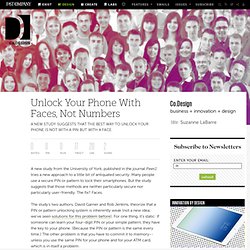
Many people use a secure PIN or pattern to lock their smartphones. But the study suggests that those methods are neither particularly secure nor particularly user-friendly. The fix? Faces. The study's two authors, David Garner and Rob Jenkins, theorize that a PIN or pattern unlocking system is inherently weak (not a new idea; we've seen solutions for this problem before). Their solution relies on the human mind's ability to recognize familiar faces.
This is a very difficult password to crack, the authors argue. Why Are We Ticklish? Why do We Laugh? How to Cope with Uncomfortable Uncertainty. Joy is not the only experience that people try to avoid, to their detriment.
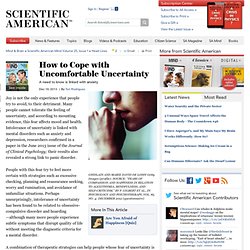
Many people cannot tolerate the feeling of uncertainty, and according to mounting evidence, this fear affects mood and health. Intolerance of uncertainty is linked with mental disorders such as anxiety and depression, researchers confirmed in a paper in the June 2013 issue of the Journal of Clinical Psychology; their results also revealed a strong link to panic disorder. First evidence of common brain code for space, time, distance. A new Dartmouth study provides the first evidence that people use the same brain circuitry to figure out space, time and social distances.
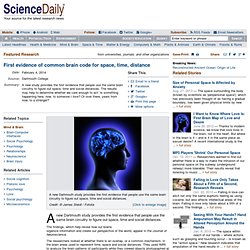
The findings, which help reveal how our brains organize information and create our perspective of the world, appear in the Journal of Neuroscience. The researchers looked at whether there is an overlap, or a common mechanism, in the brain areas used to represent time, space and social distances. They used fMRI to analyze the brain patterns of participants while they viewed objects photographed at different distances, viewed photos of friends or acquaintances and read phrases referring to the immediate or more remote future. "The results showed that the same brain patterns that decide whether something is physically near to us versus far away also decide whether we are thinking about the near or distant future or seeing a friend versus an acquaintance," said senior author Thalia Wheatley, an associate professor of Psychological and Brain Sciences. David Eagleman. David Eagleman (born April 25, 1971) is a neuroscientist and writer at Baylor College of Medicine, where he directs the Laboratory for Perception and Action and the Initiative on Neuroscience and Law.
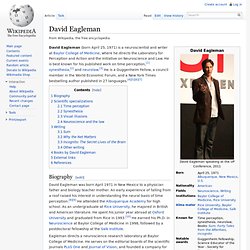
He is best known for his published work on time perception,[1] synesthesia,[2] and neurolaw.[3] He is a Guggenheim Fellow, a council member in the World Economic Forum, and a New York Times bestselling author published in 27 languages.[4][5][6][7] Biography[edit] David Eagleman was born April 1971 in New Mexico to a physician father and biology teacher mother. An early experience of falling from a roof raised his interest in understanding the neural basis of time perception.[8][9] He attended the Albuquerque Academy for high school. As an undergraduate at Rice University, he majored in British and American literature. Eagleman directs a neuroscience research laboratory at Baylor College of Medicine. Scientific specializations[edit] Francis Crick. During the remainder of his career, he held the post of J.W.
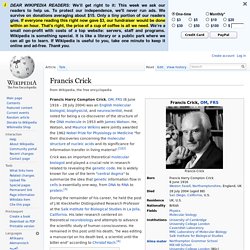
Kieckhefer Distinguished Research Professor at the Salk Institute for Biological Studies in La Jolla, California. His later research centered on theoretical neurobiology and attempts to advance the scientific study of human consciousness. He remained in this post until his death; "he was editing a manuscript on his death bed, a scientist until the bitter end" according to Christof Koch.[4] Early life and education[edit] Crick was the first son of Harry Crick (1887–1948) and Annie Elizabeth Crick (née Wilkins; 1879–1955).
At an early age, Francis was attracted to science and what he could learn about it from books.
The Future Of Memory Is Half Mind, Half Machine. You’ve already forgotten almost everything that’s ever happened to you.
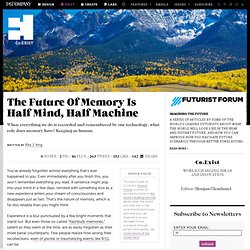
Even immediately after you finish this, you won’t remember everything you read. A sentence might pop into your mind in a few days, remixed with something else as a new experience enters your stream of consciousness and disappears just as fast. That’s the nature of memory, which is far less reliable than you might think. This Is What Wi-Fi Would Look Like, If We Could See It. Even though Wi-Fi is invisible, we know when it’s not working.
